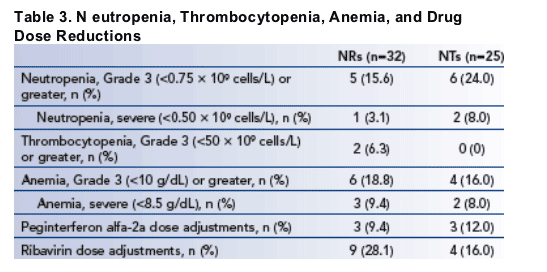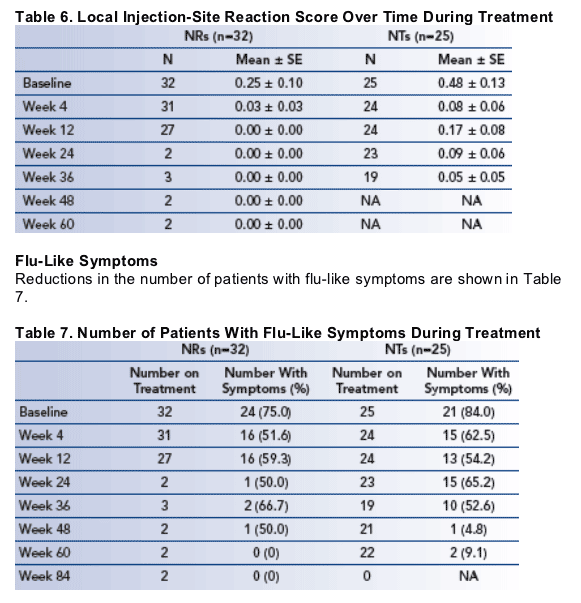 |
 |
 |
| |
Safety and Tolerability of Peginterferon Alfa-2a Plus Ribavirin in HCV Patients Nontolerant or Nonresponsive to Peginterferon Alfa-2b Plus Ribavirin
|
| |
| |
Reported by Jules Levin
DDW, May 22, 2007, Washington DC
Vinod K. Rustgi, MD1, Stephen Esposito, MD2, Fayez M. Hamzeh, MD, PhD3, and Mitchell L. Shiffman, MD4
1Liver Transplantation Unit, Georgetown University Medical Center, Washington, DC, USA; 2Hepatobiliary Associates of New York, Flushing, NY, USA; 3Roche Laboratories, Nutley, NJ, USA; 4Hepatology Section, M1872 Virginia Commonwealth University Medical Center, Richmond, VA, USA
This study was supported by Roche Laboratories.
The authors concluded that most patients who were nontolerators of PegIntron were able to tolerate Pegasys (23/25). However, a few, but few patients who were nonresponders to PegIntron responded to Pegasys virologically. In tables below you can see side effects experienced by patients on Pegasys/RBV, and the patients who mounted a virologic response.
INTRODUCTION
-- Patients infected with HCV who are treated with peginterferon alfa-2a plus ribavirin have a lower incidence of depression and flu-like symptoms than
patients treated with standard interferon plus ribavirin.1
-- In contrast, patients treated with peginterferon alfa-2b plus ribavirin had a
similar incidence of these adverse events as patients treated with standard
interferon plus ribavirin.2
-- These observations suggested that patients intolerant of peginterferon
alfa-2b plus ribavirin, especially those intolerant due to depression or flu-like
symptoms, may be more tolerant to treatment with peginterferon alfa-2a
plus ribavirin.
-- It is not known if patients nonresponsive to one form of peginterferon
plus ribavirin may be more responsive to treatment with the other form of
peginterferon plus ribavirin.
-- An open-label, multicenter trial assessed the efficacy and safety of
peginterferon alfa-2a plus ribavirin in patients infected with HCV genotype 1
who were treated with peginterferon alfa-2b plus ribavirin for a maximum of
12 weeks but did not achieve early virologic response (EVR) or were intolerant
due to depression, fatigue, flu-like symptoms, or injection-site reactions.
PATIENTS
-- Open-label, multicenter study in patients aged ≥18 years with serologic evidence of chronic infection with HCV genotype 1 and documented HCV RNA titer prior to initiation of treatment with peginterferon alfa-2b plus ribavirin.
-- Nontolerators (NTs) were patients treated with peginterferon alfa-2b plus ribavirin for a maximum of 12 weeks, but intolerant due to depression, fatigue, flu-like symptoms, and/or injection-site reactions.
-- Nonresponders (NRs) were patients treated with peginterferon alfa-2b plus ribavirin who did not achieve EVR, defined as a ≥2-log10 decrease or undetectable HCV RNA (≥60 IU/mL) after 12 weeks.
Assessments
--Serum HCV RNA concentration was quantified using the Roche Amplicor PCR assay, with a lower limit of detection of 60 IU/mL.
--Depression was evaluated at screening, baseline, and each subsequent visit using the BDI-II.3 Per protocol, any patient with a BDI-II score ≥22 was referred
for professional psychiatric assessment (and possible initiation of antidepressant
treatment) to determine if that patient could be safely continued in the study; any
patient with a BDI-II score ≥31 was discontinued.
--Fatigue was measured at screening, baseline, and each subsequent visit using the Fatigue Severity Scale (FSS).4
--A local injection-site reaction grading tool was used to evaluate pain/discomfort
and intensity of injection-site reactions.
--A flu-like symptom questionnaire was used to evaluate the incidence of headache, fever, myalgia, and rigors at screening and at all subsequent visits.
RESULTS
32 NRs and 25 NTs enrolled:
- 14 NTs (56%) achieved EVR on peginterferon alfa-2b plus ribavirin.
- 19 NTs (76%) withdrew from peginterferon alfa-2b plus ribavirin due to fatigue,
3 (12%) due to flu-like symptoms, 2 (8%) due to injection-site reactions, and
1 (4%) due to depression.
Table 1. Patient Characteristics at Start of Peginterferon Alfa-2a
Plus Ribavirin
HCV RNA at baseline was 5.29 in Nonresponders and 2.99 log IU/mL in nontoleraters.

Treatment Completion
26 NRs (81%) and 24 NTs (96%) completed treatment with peginterferon alfa-2a plus ribavirin or were withdrawn for insufficient response at Week 12.
Withdrawals and Dose Adjustments
NRs
-- 4 (12.5%) were withdrawn from peginterferon alfa-2a plus ribavirin due to adverse events or intercurrent illness: 1 each for thrombocytopenia, blurred vision, pelvic fracture, and cough.
-- Per protocol, 24 (75%) were withdrawn at 12 weeks for insufficient response.
-- 1 (3.1%) failed to return and 1 (3.1%) refused treatment/withdrew consent.
-- 2 (6.3%) completed 60 weeks of treatment with peginterferon alfa-2a plus ribavirin and entered follow-up.
NTs
-- None was withdrawn from peginterferon alfa-2a plus ribavirin due to adverse events or intercurrent illness.
--Per protocol, 1 (4%) was withdrawn at 12 weeks for insufficient response.
-- 1 (4%) refused treatment/withdrew consent.
-- 23 (92%) completed 36 weeks of treatment with peginterferon alfa-2a plus ribavirin and entered follow-up.
- Hematologic abnormalities and dose adjustments of peginterferon alfa-2a and
ribavirin are shown in Table 3. Rates observed were similar to those previously
seen during treatment with peginterferon alfa-2a and ribavirin.
AUTHOR CONCLUSIONS
23 of 25 NTs to peginterferon alfa-2b plus ribavirin tolerated treatment with peginterferon alfa-2a plus ribavirin.
- While on treatment with peginterferon alfa-2a plus ribavirin,
these patients showed reductions in symptoms that made them
discontinue treatment with peginterferon alfa-2b plus ribavirin.
- These findings suggest that patients who experience marked
depression, fatigue, local injection-site reaction, or flu-like
symptoms while on peginterferon alfa-2b plus ribavirin are
likely to experience a lower incidence of flu-like symptoms
and other systemic adverse events if converted to or retreated
with peginterferon alfa-2a plus ribavirin.
Most NRs to peginterferon alfa-2b plus ribavirin also did not respond to 12 weeks of treatment with peginterferon alfa-2a plus ribavirin, suggesting the need for a less stringent stopping rule.
As expected, nontolerators of peginterferon alfa-2b plus ribavirin had a higher SVR rate than nonresponders when retreated with peginterferon alfa-2a plus ribavirin.
50 of 57 (87.7%) patients infected with HCV genotype-1 who could not tolerate or did not respond to 12 weeks of treatment with peginterferon alfa-2b plus ribavirin completed treatment with peginterferon alfa-2a plus ribavirin or were withdrawn for insufficient response at Week 12.



Key Exclusion Criteria
-- Receipt of any systemic antiviral therapy or investigational drug, other than
peginterferon alfa-2b plus ribavirin, for 24 weeks prior to the first dose of
peginterferon alfa-2a plus ribavirin (except for those who had a ≦7-day course
of acyclovir for herpetic lesions >1 month prior to the first dose of peginterferon
alfa-2a plus ribavirin); or those expected to need systemic antiviral therapy.
-- Seropositivity for antihepatitis A virus IgM Ab, hepatitis B surface antigen,
antihepatitis B core protein IgM, or anti-HIV.
-- History or other evidence of chronic liver disease or decompensated cirrhosis.
Pregnant or breastfeeding women and male partners of pregnant women.
Serum creatinine concentration >1.5 times upper limit of normal (ULN) or advanced renal disease.
-- Evidence of alcohol and/or drug abuse within 6 months of entry or refusal to agree to abstain from alcohol during the entire course of treatment and follow-up.
-- History of severe psychiatric disease, especially depression; a total score of ≥31 on the Beck Depression Inventory Second Edition (BDI-II)3 or a score of 2 or 3 on Question 9 of the BDI-II.
-- History of hypomanic or manic episodes or bipolar disorder, or active severe
seizure disorder.
Treatments
-- NRs were treated for 60 weeks with peginterferon alfa-2a (180 _g sc once weekly) plus ribavirin (1,000 or 1,200 mg/day), and followed up 24 weeks later.
NTs were treated for 36 weeks with peginterferon alfa-2a (180 _g sc once weekly) plus ribavirin (1,000 or 1,200 mg/day), and followed up 24 weeks later.
-- Per protocol, patients with detectable HCV RNA after 12 weeks of treatment with peginterferon alfa-2a plus ribavirin were discontinued from treatment.
REFERENCES
1. Fried MW, Shiffman ML, Reddy KR, et al. Peginterferon alfa-2a plus ribavirin for chronic hepatitis C virus infection. N Engl J Med. 2002;347:975-982.
2. Manns MP, McHutchison JG, Gordon SC, et al, and the International Hepatitis Interventional Therapy Group. Peginterferon alfa-2b plus ribavirin compared with
interferon alfa-2b plus ribavirin for initial treatment of chronic hepatitis C: a randomised trial. Lancet. 2001;358:958-965.
3. Beck AT, Steer RA, Brown GK. Beck Depression Inventory-II (BDI-II). 2nd ed. San Antonio, Tex: Harcourt Assessment, 1996.
4. Krupp LB, LaRocca NG, Muir-Nash J, Steinberg AD. The Fatigue Severity Scale: application to patients with multiple sclerosis and systemic lupus erythematosus. Arch Neurol. 1989;46:1121-1123.
|
| |
|
 |
 |
|
|